Thermalright Ultra 120 Extreme: Is More Better?
by Wesley Fink on March 7, 2007 12:05 AM EST- Posted in
- Cases/Cooling/PSUs
As testing on the Thermalright Ultra 120 was nearing completion, Thermalright contacted us and asked if we would like to take a look at a new Thermalright cooler that was "even better than the Ultra 120". With the Ultra 120 rising to the top of our heatpipe tower performance charts, the answer was a definite "Yes".
A few days later a package arrived from Taiwan in the stock Thermalright plain brown box. There was not even a new ID on the package for this new cooler, but Thermalright told us it would be called the Thermalright Ultra 120 Extreme. So what is improved on the new Ultra 120 Extreme?
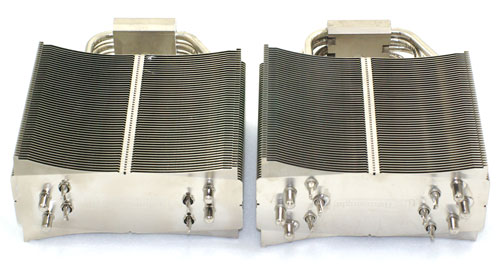
As you can see in the side-by-side comparison with the current Ultra 120, Thermalright has managed to add two more heatpipes to the Ultra 120 Extreme, raising the total heatpipes from four to six. Everything else about the Ultra 120 Extreme seems to be exactly the same as the existing Ultra 120.
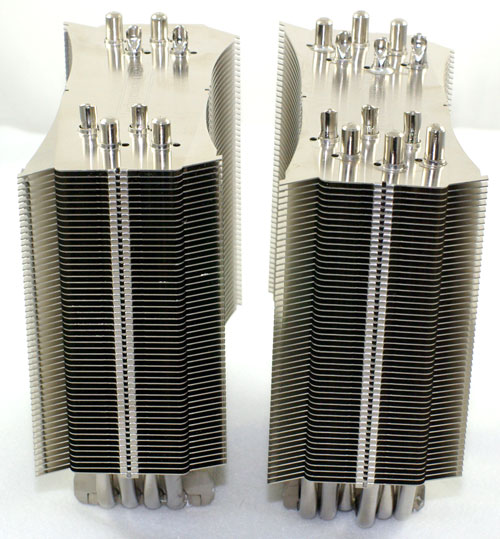
It is always good to see more heatpipes for cooling - particularly in a design that has proven to perform very well as the Ultra 120 has. We wondered, however, exactly how much difference two added heatpipes could make in the performance of the Ultra 120. Was it enough of a difference to justify Thermalright's enthusiasm about the new design?
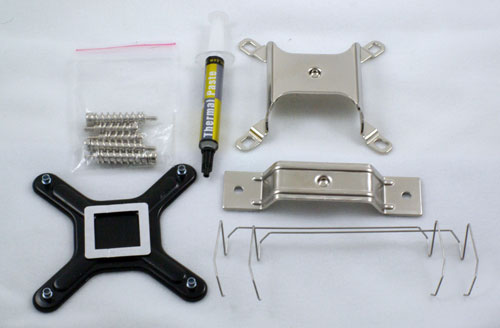
Thermalright also updated the kit with the Ultra 120 Extreme. Where the AM2 adapter is an optional accessory with the Ultra 120 kit, the Socket 775, AM2, and AMD 754/939/940 adapters are all included with the Ultra 120 Extreme.
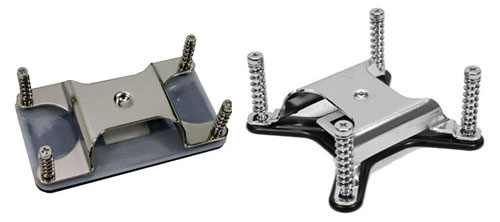
The addition of two extra heatpipes is pretty straightforward. However, the location of the added pipes does create some issues with the Intel socket 775 adapter carried over from the current Ultra 120 kit. The adapter frankly won't fit through the heatpipes in the new design. We actually had to bend the Socket 775 adapter to mount the Ultra 120 Extreme on a Core 2 Duo.
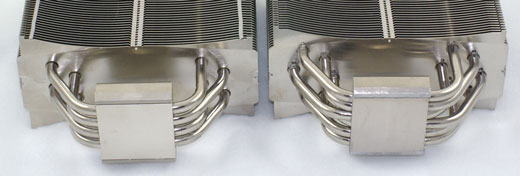
We have alerted Thermalright to the problem, and we sincerely hope they will make modifications to the Socket 775 bracket before shipping the Extreme kits to the retail channel. Those handy with tools will find a way to mount the Ultra 120 Extreme on a Socket 775, but most users will want an adapter that is easier to work with.

To isolate just the impact of the Extreme modification we tested with the same Scythe S-Flex fan used in the Thermalright Ultra 120 review. This excellent fan moves a lot of air, but still keeps noise low with the Sony developed Fluid Dynamic Bearing on the fan motor.
A few days later a package arrived from Taiwan in the stock Thermalright plain brown box. There was not even a new ID on the package for this new cooler, but Thermalright told us it would be called the Thermalright Ultra 120 Extreme. So what is improved on the new Ultra 120 Extreme?

As you can see in the side-by-side comparison with the current Ultra 120, Thermalright has managed to add two more heatpipes to the Ultra 120 Extreme, raising the total heatpipes from four to six. Everything else about the Ultra 120 Extreme seems to be exactly the same as the existing Ultra 120.

It is always good to see more heatpipes for cooling - particularly in a design that has proven to perform very well as the Ultra 120 has. We wondered, however, exactly how much difference two added heatpipes could make in the performance of the Ultra 120. Was it enough of a difference to justify Thermalright's enthusiasm about the new design?

Thermalright also updated the kit with the Ultra 120 Extreme. Where the AM2 adapter is an optional accessory with the Ultra 120 kit, the Socket 775, AM2, and AMD 754/939/940 adapters are all included with the Ultra 120 Extreme.

The addition of two extra heatpipes is pretty straightforward. However, the location of the added pipes does create some issues with the Intel socket 775 adapter carried over from the current Ultra 120 kit. The adapter frankly won't fit through the heatpipes in the new design. We actually had to bend the Socket 775 adapter to mount the Ultra 120 Extreme on a Core 2 Duo.

We have alerted Thermalright to the problem, and we sincerely hope they will make modifications to the Socket 775 bracket before shipping the Extreme kits to the retail channel. Those handy with tools will find a way to mount the Ultra 120 Extreme on a Socket 775, but most users will want an adapter that is easier to work with.

To isolate just the impact of the Extreme modification we tested with the same Scythe S-Flex fan used in the Thermalright Ultra 120 review. This excellent fan moves a lot of air, but still keeps noise low with the Sony developed Fluid Dynamic Bearing on the fan motor.










54 Comments
View All Comments
Visual - Wednesday, March 7, 2007 - link
now it's time that someone combines this 6-pipe ultra with a "TEC" or whatever its called in its basewhat could the results be....
Lord Evermore - Monday, March 12, 2007 - link
Probably worse, or at least no better. The contact area of the TEC with the cooler is limited to the size of the cooler base. That's not a heck of a lot larger than the contact area of the CPU itself, and assumes you could actually fit in a TEC to cover the entire heatsink plate. A TEC generates heat, it cools one side, that heat is put out on the other side, plus extra heat from the energy used by the TEC. So you'd have more heat (and of course, the more energy used, the better the cooling, and the more excess heat generated) being transferred to the same or slightly more surface area of the heatsink. With equal contact areas, there's just no way for a TEC to actually provide better cooling. It might cool really well for a very short period, but then it would burn out if that heatsink contact wasn't able to carry away the heat well enough. If the heatsink can't cool the CPU down to ambient, it won't be able to cool a TEC any lower with the same contact.The old days of using TECs are pretty much gone, because of the issues involved. But when they are used, they're used in conjunction with a larger heatsink, both in contact area and radiating fin area. Or with liquid cooling.
Reynod - Wednesday, March 7, 2007 - link
Nice review Wes ... liked it.Well done Thermalright ... good response to customer needs.
Thermaltake should take a page out of this book and produce some decent stuff that works ... the emphasis on bling might be fine with noobs ... but they are off my shopping list as an overclocker
sephiros64 - Wednesday, March 7, 2007 - link
is it confirmed that the new model will be the 120 ultra plus ? I'm sure a lot of consumers looking for this product will want this newer, better version and are concerned of the model number when ordering.ceefka - Wednesday, March 7, 2007 - link
I am still hoping for a review of this model. I want to cool my CPU fanless. The airflow is already taken care of with two Nexus 92mm intake fans @5v and 120mm Antec Tricool (low rpm) exhaust fan.Is that S-Flex fan also suitable to operate as case exhaust fan?
Wesley Fink - Wednesday, March 7, 2007 - link
If your case can mount 120mm fans the Scythe S-Flex will operate fine as a case exhaust fan.Philxxx - Wednesday, March 7, 2007 - link
Hi,im fairly new to custom building computers and i wonder if there is a performance change when the heatpipes are placed vertically vs. horizontaly like your picture indicates.
From what i understand so far a heatpipe evaporates a fluid inside the pipe and uses the vapor to transport the heat away from the CPU. Would the heatpipes and the evaporation/condensation proccess behave different when the cooler is mouted vertically like in a tower? Any chance to test this senario?
Regards,
Philipp
Wesley Fink - Wednesday, March 7, 2007 - link
From the Test Configuration (p. 3)of the Thermalright Ultra 120 review: "All cooling tests are run with the components mounted in a standard mid-tower case. The idle and stress temperature tests are run with the case closed and standing as it would in most home setups. We do not use auxiliary fans in the test cooling case, except for the north bridge fan attached to the 680i for overclocking."yyrkoon - Wednesday, March 7, 2007 - link
I can not help but wonder how much better all the coolers in your roundup would do with a 'better' fan. There are fans out there, with two ball bearings that will push 220CFM. Granted, if memory serves, these fans also exhibit 65+ dba noise levels, but it would be interesting to see the results.Barring a 220CFM fan pushing too much air ( dislodging a cooler in the process, heh ), I would at least expect minimal improvements.
http://epowerhousepc.com/delta-120x38mm-tfb1212ghe...">Link
Ender17 - Wednesday, March 7, 2007 - link
Any idea when this will be available?Or any word of an improved mounting mechanism for 775?